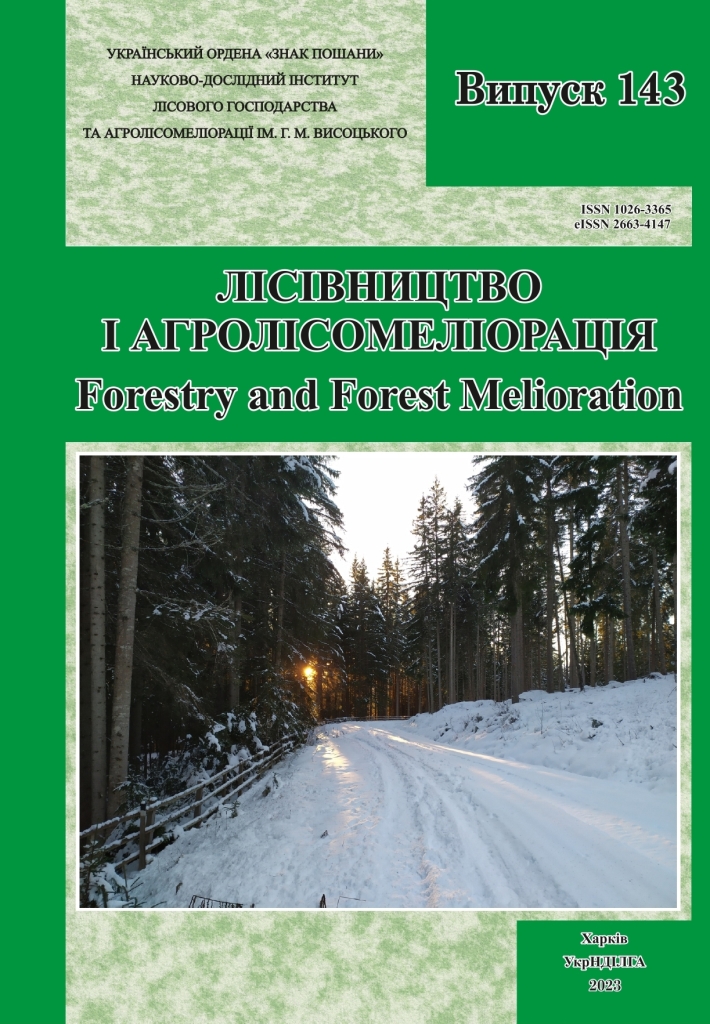Abstract
Introduction
Pine stands of many regions have been affected by outbreaks of bark beetles with the dominance of Ips acuminatus (Gyllenhal, 1827) and Ips sexdentatus (B?rner, 1776). In many countries, pheromone traps are produced and used to monitor and suppress native and alien bark beetles. In Ukraine, pheromone traps for catching bark beetles are not produced. The effectiveness of various trap designs and the number of lures for pine bark beetles have not been previously studied in Ukraine. In 2023, within the framework of the FAO project TCP/RER/3801, State Specialized Forest Protection Enterprise ‘Kharkivlisozahyst’ received three types of pheromone traps produced by the Spanish company Sanidad agricola econex s.l. and pheromones intended for the capture of I. acuminatus and I. sexdentatus.
The study aimed to compare the species composition and abundance of bark beetles and their predators by captures in the different pheromone trap-lure combinations.
Materials and Methods
The research was carried out in June – August 2023 in pure mature pine stands in the Vasishcheve subunit (State Specialized Forest Enterprise “Forests of Ukraine”, Branch “Zhovtneve Forestry”). Three types of pheromone traps were placed randomly in six locations of a homogeneous stand, the distance between which was about 50 meters. Type A traps (Funnel) contain 8 funnels, Type B traps are Theyson, and Type C traps are Crosstrap® mini. Depending on the experimental design, the traps contained blades with pheromones of Ips acuminatus or Ips sexdentatus. Blades for I. acuminatus contained 2 and 3 dispensers (commercial names 4C and 5C, respectively), and blades for I. sexdentatus contained 3 and 4 dispensers (commercial names 4C and 5C, respectively). In control treatments, respective traps (A, B, and C) were left empty (without blades). Trapping experiments were carried out from 20 June through 8 August 2023. Trapped insects were collected every 7 days, dried, and sorted. Bark beetles, longhorn beetles, and predators were identified at the species level, and some other insect groups at the family level at least.
Results and Conclusions
Five bark beetle species (Curculionidae: Scolytinae), five longhorn beetles (Cerambycidae), five predator species from Histeridae, Cleridae, Nitidulidae, Monotomidae, and Tenebrionidae, as well as several species of Staphylinidae, Carabidae, and Elateridae were captured in traps of three types (A – Funnel; B – Theyson; C – Crosstrap® mini) with pheromones of Ips acuminatus and I. sexdentatus. Target species – Ips acuminatus and I. sexdentatus – accounted for 51% and 31% of all captured beetles, respectively. Their numbers, seasonal dynamics, and proportions depended on the trap type, pheromone, and blade. The highest number of I. acuminatus beetles was captured in Crosstrap® mini traps (C type), and that of I. sexdentatus was found in Theyson traps (type B). An increase in dispenser number provides more captures of I. acuminatus and has no significant influence on captures of I. sexdentatus. The number of Th. formicarius was the lowest in trap B (Theyson) and the highest in trap С (Crosstrap® mini). The number of Th. formicarius captured in traps A and C with the pheromone of I. acuminatus was higher than in the traps with the pheromone of I. sexdentatus. Differences in the captured Th. formicarius beetles in the traps with more dispensers with the pheromone of I. acuminatus are significant, whereas in the traps with the pheromone of I. sexdentatus they are nonsignificant.
12 Figs., 14 Refs.
References
Andreieva, O. Yu., Vyshnevskyi, A. V., Boliujh, S. V. 2019. Population dynamics of bark beetles in the pine forests of Zhytomyr region. Scientific Bulletin of UNFU, 29(8): 31–35(in Ukrainian). https://doi.org/10.36930/40290803
Atramentova, L. A. and Utevskaya, O. M. 2008. Statistical methods in biology. Gorlovka, Likhtar, 248 p. (in Russian).
Colombari, F., Schroeder, M. L., Battisti, A., Faccoli, M. 2013. Spatio-temporal dynamics of an Ips acuminatus outbreak and implications for management. Agricultural and Forest Entomology, 15: 34–42. https://doi.org/10.1111/j.1461-9563.2012.00589.x
Erdo?an, C. 2024. Investigation of possible use of pheromone trap for adult population development and control of Ips sexdentatus (B?rner, 1776) (Coleoptera: Scolytidae) damaging black pine in Ba?kent University Ba?l?ca Campus afforestation area. Turkish Journal of Entomology, 48(1): 3–14. https://doi.org/10.16970/entoted.1352020
Faccoli, M., Gallego, D., Branco, M., Brockerhoff, E. G., Corley, J., Coyle, D. R., ... , Avtzis, D. 2020. A first worldwide multispecies survey of invasive Mediterranean pine bark beetles (Coleoptera: Curculionidae, Scolytinae). Biological Invasions, 22: 1785–1799. https://doi.org/10.1007/s10530-020-02219-3
Kn??ek, M., Li?ka, J., V?le, A. 2022. Efficacy of synthetic lures for pine bark beetle monitoring. Journal of Forest Science, 68(1): 19–25. https://doi.org/10.17221/139/2021-JFS
Lantschner, M. V. and Corley, J. C. 2023. Spatiotemporal outbreak dynamics of bark and wood-boring insects. Current Opinion in Insect Science, 55: 101003. https://doi.org/10.1016/j.cois.2022.101003
Li?ka J., Kn??ek M., V?le A. 2021. Evaluation of insect pest occurrence in areas of calamitous mortality of Scots pine. Central European Forestry Journal, 67: 85–90. https://doi.org/10.2478/forj-2021-0006
Meshkova, V. 2021. The lessons of Scots pine forest decline in Ukraine. Environ. Sci. Proc., 3 (1): 28. https://doi.org/10.3390/IECF2020-07990/
Meshkova, V. L., Vorobei, A. D., Omelich, A. R. 2022. Coleopterous predators of bark beetles in the last years of the outbreak. Folia Forestalia Polonica, Series A – Forestry, 64 (3): 161–172. https://doi.org/10.2478/ffp-2022-0016
Miller, D. R. and Asaro, C. 2023. Predators attracted to combination of bark beetle pheromones and host kairomones in pine forests of southeastern United States. Environmental Entomology, 52(5): 787–794. https://doi.org/10.1093/ee/nvad076
Vorobei, A. D. 2022. Species composition dynamics for bark beetles and their predators from Coleoptera family in pine stands of the Zhovtneve State Forest Enterprise (Kharkiv region) in 2019–2022. Forestry and Forest Melioration, 141: 110–116 (in Ukrainian). https://doi.org/10.33220/1026-3365.141.2022.110
Warzee, N., Gilbert, M., Gregoire, J. C. 2006. Predator/prey ratios: a measure of bark-beetle population status influenced by stand composition in different French stands after the 1999 storms. Annals of Forest Science, 63(3): 301–308. https://doi.org/10.1051/forest:2006009
Wermelinger, B., Rigling, A., Schneider Mathis, D., Kenis, M., Gossner,M. M. 2021. Climate change effects on trophic interactions of bark beetles in inner alpine Scots pine forests. Forests, 12(2): 136–151. https://doi.org/10.3390/f12020136

This work is licensed under a Creative Commons Attribution 4.0 International License.
